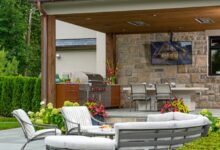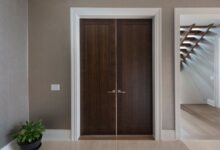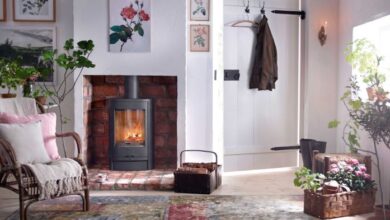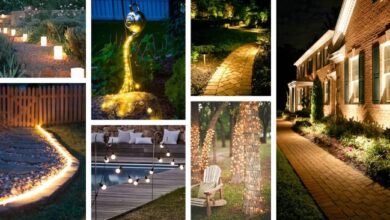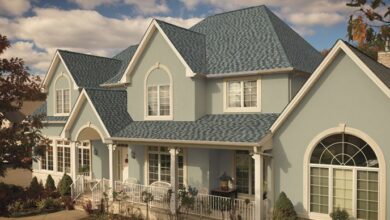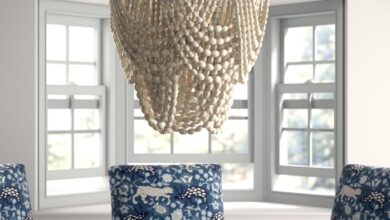Scandinavian Interior Design A Comprehensive Guide
Scandinavian interior design embodies a philosophy of simplicity, functionality, and connection with nature. This aesthetic, born from the Nordic countries’ long winters and appreciation for natural light, prioritizes clean lines, natural materials, and a calming color palette. It’s more than just a style; it’s a lifestyle choice emphasizing comfort, sustainability, and a sense of calm amidst the everyday.
Characterized by its minimalist approach and emphasis on functionality, Scandinavian design contrasts with other styles by prioritizing practicality and understated elegance over ornate details. Unlike the often-stark minimalism of other design movements, Scandinavian interiors incorporate warmth through textures, natural light, and carefully chosen accessories. The historical influences, ranging from the functionalist movements of the early 20th century to the enduring appeal of handcrafted goods, contribute to its unique and enduring appeal.
Defining Scandinavian Style
Scandinavian design, often referred to as Nordic design, is more than just a fleeting trend; it’s a timeless aesthetic deeply rooted in the region’s history, climate, and cultural values. Its enduring appeal lies in its ability to seamlessly blend functionality, minimalism, and a sense of warmth and coziness. This style prioritizes simplicity, natural materials, and a light and airy atmosphere, creating spaces that are both beautiful and practical.Scandinavian style emphasizes functionality and simplicity, prioritizing clean lines and uncluttered spaces.
This focus on practicality stems from a history of resourcefulness and a desire to maximize limited space and natural light, especially in the long, dark winters of the Nordic countries. The aesthetic avoids ostentation and instead focuses on creating a calm and inviting atmosphere conducive to relaxation and well-being.
Core Principles of Scandinavian Interior Design
The core principles of Scandinavian design revolve around functionality, minimalism, and the use of natural materials. Light, neutral color palettes dominate, often featuring shades of white, gray, and beige, accented with pops of color from nature, such as deep blues, greens, and earthy tones. Natural materials like wood, wool, and linen are extensively used, contributing to a sense of warmth and texture.
Simple, elegant furniture with clean lines and unfussy designs is preferred, prioritizing both form and function. This approach creates spaces that are both aesthetically pleasing and highly functional, reflecting a practical and efficient approach to design.
Comparison with Minimalist and Modern Styles
While Scandinavian design shares similarities with minimalist and modern styles, key distinctions exist. Minimalism, at its core, prioritizes reduction to the absolute essentials, often resulting in a stark and somewhat austere aesthetic. Scandinavian design, while minimalist in its approach to clutter, incorporates warmth and texture through the use of natural materials, creating a more inviting and less stark environment.
Modern design, on the other hand, often embraces bolder colors, geometric patterns, and a more industrial aesthetic. Scandinavian design maintains a softer, more organic feel, emphasizing natural light and a sense of coziness often missing in strictly modern interiors. The difference is subtle but significant, creating distinct moods and atmospheres.
Historical Influences on Scandinavian Design
Scandinavian design’s evolution is deeply intertwined with the region’s history and climate. The long, dark winters and limited daylight hours have heavily influenced the preference for light, airy spaces and the use of reflective surfaces to maximize natural light. The region’s history of craftsmanship and its focus on functionality have also shaped the style, emphasizing simple, well-made furniture and objects designed for practicality and durability.
The Arts and Crafts movement, with its emphasis on handcrafted items and natural materials, also significantly impacted Scandinavian design, contributing to its emphasis on quality and sustainability. The mid-20th-century rise of functionalism further solidified the style’s focus on clean lines, simple forms, and the integration of art and design into everyday life.
The Use of Natural Light in Scandinavian Interiors
Natural light plays a crucial role in Scandinavian interior design. Given the long, dark winters in the Nordic countries, maximizing natural light is paramount. Large windows, often floor-to-ceiling, are a common feature, allowing ample sunlight to flood the interior. Light-colored walls and floors reflect light, further enhancing the brightness of the space. Mirrors are strategically placed to bounce light around the room, creating a sense of spaciousness and openness.
The use of sheer curtains or blinds allows for control over the amount of light entering the room while maintaining a sense of airiness. This thoughtful consideration of natural light is essential to the overall atmosphere of a Scandinavian interior, creating a bright, welcoming, and uplifting space even during the darkest months.
Color Palettes and Materials
Scandinavian interior design is renowned for its understated elegance and functionality, achieved through a careful selection of colors and materials. The overall aesthetic prioritizes natural light, creating a sense of spaciousness and calm. This is reflected in the choice of both color palettes and the materials used in the design.
The color palette typically features a muted and neutral base, allowing natural light to permeate the space. This foundation is then accented with carefully chosen pops of color to add visual interest without overwhelming the serene atmosphere. The emphasis is always on creating a feeling of balance and harmony.
Scandinavian Color Palette Examples
A typical Scandinavian color palette might include:
- Off-white or warm white: This forms the base, providing a bright and airy backdrop. Think of the soft, slightly creamy white of fresh snow rather than a stark, clinical white.
- Light greys: These add a touch of sophistication and depth without being too dark or heavy. Soft, cool greys work well, echoing the colors of a cloudy Scandinavian sky.
- Natural wood tones: The varying shades of wood, from light blonde to deeper browns, add warmth and texture to the palette. These tones are considered a color in themselves, enriching the overall scheme.
- Muted blues and greens: These colors, reminiscent of the sea and landscape, introduce a calming and refreshing element. Think muted teal or dusty sage green, rather than bright, saturated hues.
- Black accents: Used sparingly, black provides a grounding contrast and highlights architectural details or furniture pieces. It’s crucial to use black as a subtle accent, rather than a dominant color.
Common Materials in Scandinavian Interiors
The materials used in Scandinavian design reflect a commitment to natural elements and durability. The focus is on quality over quantity, with a preference for materials that age gracefully and contribute to a sense of timeless style.
- Wood: A staple material, often used in flooring, furniture, and wall paneling. Light woods like birch and pine are popular, contributing to the bright and airy feel.
- Textiles: Natural fibers such as wool, linen, and cotton are preferred for their texture, breathability, and sustainability. These materials add warmth and comfort to the space.
- Stone: While less common than wood, stone, particularly light-colored stone, can be used in flooring or countertops to add a touch of rugged elegance.
- Leather: Often used in upholstery or accessories, leather adds a touch of luxury and durability. Again, natural tones are preferred.
- Metal: Metals like brass or copper are used sparingly as accents, adding a touch of warmth and visual interest.
Sustainability in Scandinavian Material Choices
Sustainability is a key consideration in Scandinavian design. The preference for natural, durable materials reflects a commitment to minimizing environmental impact. The emphasis on longevity means furniture and decor are chosen for their quality and intended to last for many years, reducing the need for frequent replacements. Sourcing materials locally and using reclaimed wood also contribute to a more sustainable approach.
Example Scandinavian Room Design, Scandinavian interior design
Imagine a living room with off-white walls and light oak flooring. A large, light grey sofa sits against one wall, complemented by a sheepskin rug for added texture and warmth. A coffee table made from reclaimed wood sits in the center, alongside two armchairs upholstered in a muted teal linen. A few carefully selected accessories, such as a ceramic vase in a dusty sage green and a brass lamp, add subtle pops of color and visual interest.
The overall mood is one of calm, understated elegance, promoting relaxation and a sense of well-being. The natural light streaming through the large windows enhances the airy and spacious feel, perfectly embodying the Scandinavian aesthetic.
Furniture and Furnings: Scandinavian Interior Design
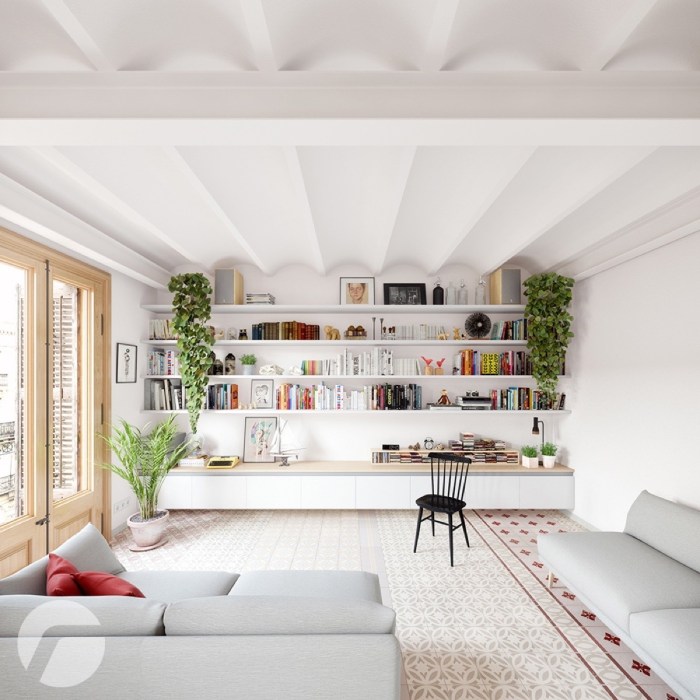
Source: home-designing.com
Scandinavian furniture design is integral to the overall aesthetic of the style. It’s not merely about the pieces themselves, but how they contribute to a sense of light, airy space and functionality. The furniture choices reflect the core values of simplicity, functionality, and natural materials, creating an atmosphere of understated elegance and comfort.The characteristics of Scandinavian furniture are deeply intertwined with the region’s history and climate.
Long winters and a need for practicality led to designs that were both beautiful and durable, prioritizing functionality without sacrificing style. This focus on practicality extends to the materials used, with a preference for sustainable and ethically sourced wood, as well as other natural elements.
Iconic Scandinavian Furniture Pieces and Designers
Several iconic pieces of furniture represent the best of Scandinavian design. These designs often blend simple lines with masterful craftsmanship, resulting in pieces that are both timeless and highly sought after. Their enduring appeal lies in their ability to seamlessly integrate into various settings while retaining their unique character.
- The Wishbone Chair by Hans Wegner: This chair, with its distinctive Y-shaped back, exemplifies the elegant simplicity of Scandinavian design. The gracefully curved wood is both comfortable and visually striking.
- The Egg Chair by Arne Jacobsen: A testament to mid-century modern design, the Egg Chair’s smooth, organic form and luxurious upholstery offer a striking contrast to the minimalist aesthetic often associated with Scandinavian design, but remains within its broader ethos.
- The Panton Chair by Verner Panton: Though technically Danish Modern, its use of vibrant color and plastic, alongside its bold, futuristic form, shows the versatility and occasional departure from strictly traditional Scandinavian design.
- The CH24 Chair (Y-Chair) by Hans J. Wegner: Another Wegner masterpiece, known for its simple yet refined lines and exceptional comfort.
Characteristics of Scandinavian Furniture
Scandinavian furniture is defined by its emphasis on several key characteristics. These characteristics work together to create pieces that are both aesthetically pleasing and highly functional. The designs are often passed down through generations, reflecting their durability and timeless appeal.
- Functionality: Scandinavian furniture prioritizes practicality. Pieces are designed to serve a purpose efficiently and effectively.
- Simplicity: Clean lines, minimal ornamentation, and a focus on natural materials define the aesthetic.
- Natural Materials: Wood, particularly light-colored woods like birch and ash, are favored for their beauty and sustainability.
- Lightness: Furniture often has a visually light and airy feel, contributing to the overall sense of spaciousness.
- Craftsmanship: High-quality materials and meticulous craftsmanship are essential aspects of Scandinavian furniture making.
Essential Furniture Pieces for a Scandinavian Living Room
Creating a successful Scandinavian living room requires careful selection of furniture. The pieces should complement each other and contribute to the overall atmosphere of light, airy space, and understated elegance. Multi-functional pieces are especially valuable in this style.
- A comfortable sofa in a neutral fabric or light-colored leather.
- An armchair or two, possibly in a contrasting yet complementary fabric or material.
- A coffee table with clean lines and a simple design.
- A side table or two for lamps and other accessories.
- A rug to define the space and add warmth underfoot.
- Storage solutions, such as a shelving unit or storage ottoman, to keep the space clutter-free.
Incorporating Vintage or Repurposed Furniture into a Scandinavian Space
Vintage and repurposed furniture can add character and personality to a Scandinavian-inspired space. The key is to select pieces that align with the style’s core values of simplicity, functionality, and natural materials. A well-chosen vintage piece can become a focal point, adding a unique touch to the overall design.
For example, an old wooden chest could be repurposed as a coffee table, or a vintage armchair could be reupholstered in a light-colored, natural fabric. The goal is to integrate the vintage piece seamlessly into the overall aesthetic, ensuring it complements rather than clashes with the other elements in the room.
Lighting and Accessories
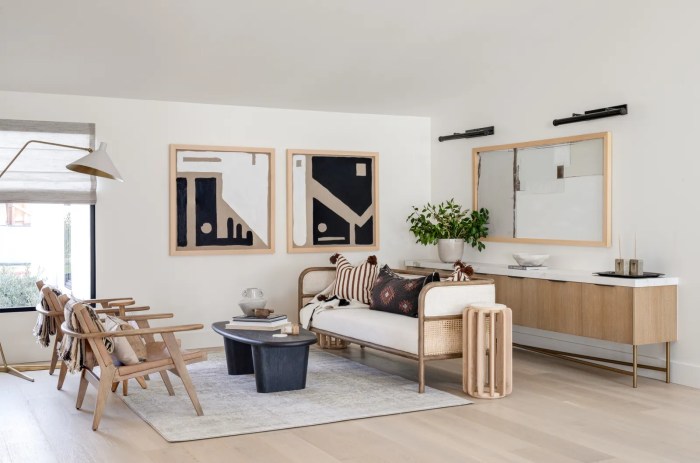
Source: architecturaldigest.com
Lighting is paramount in achieving the signature airy and inviting ambiance of Scandinavian interior design. The long, dark winters of Scandinavian countries necessitate a thoughtful approach to illumination, emphasizing natural light during the day and creating a warm, comforting glow at night. A well-planned lighting scheme is crucial for enhancing the functionality and aesthetic appeal of a Scandinavian space.
Scandinavian Bedroom Lighting Plan
A Scandinavian bedroom benefits from a layered lighting approach, combining ambient, task, and accent lighting to create a versatile and mood-setting environment. Ambient lighting, provided by a ceiling fixture, establishes the overall brightness. A simple, minimalist flush mount or a semi-flush mount fixture with a white or off-white shade would be suitable. Task lighting, crucial for reading or getting ready in the morning, could be achieved with bedside table lamps.
These lamps should have simple, clean lines, perhaps with a fabric shade in a natural tone like linen or cotton. Accent lighting adds a touch of drama and highlights specific features. This could involve a small floor lamp in a corner, perhaps with a sculptural base, or strategically placed wall sconces flanking the bed. All light sources should ideally use warm-toned LED bulbs to create a cozy atmosphere.
Typical Scandinavian Accessories
Scandinavian accessories are characterized by their simplicity, functionality, and natural materials. They are carefully selected to add warmth and personality without overwhelming the minimalist aesthetic.
Textiles play a vital role. Think soft, natural fabrics like wool, linen, and cotton in muted tones. These could include throws draped over the sofa or bed, cushions in various textures and patterns, and rugs made from natural fibers. Artwork typically features simple lines, natural scenes, or abstract designs in muted colours. Prints featuring Scandinavian landscapes, minimalist geometric patterns, or botanical illustrations are popular choices.
Plants, particularly those with a calming, natural presence, are a staple of Scandinavian design. Consider incorporating plants like succulents, ferns, or snake plants in simple pots.
Using Accessories to Enhance Scandinavian Spaces
Accessories are key to injecting personality and warmth into a Scandinavian space, which can sometimes feel stark without them. The key is to use them sparingly and strategically. A carefully chosen throw blanket in a rich texture adds visual interest and tactile comfort. A few well-placed cushions in coordinating colours and patterns introduce subtle pops of colour and pattern.
A handcrafted ceramic vase holding a single stem adds a touch of elegance and artistry. Artwork should be selected to reflect the homeowner’s personal style and preferences, adding a layer of individuality. The overall effect should be one of understated elegance and comfortable functionality. Avoid overcrowding the space; less is more in Scandinavian design.
Room-Specific Design
The principles of Scandinavian design, emphasizing functionality, minimalism, and natural light, translate beautifully into various rooms within a home. By thoughtfully selecting materials, colours, and furniture, each space can embody the essence of this popular style while maintaining its unique purpose.
Scandinavian Kitchen Design
A Scandinavian kitchen prioritizes functionality and clean lines. A galley or L-shaped layout is often preferred for efficiency, maximizing space and minimizing clutter. Appliances, typically stainless steel or white, are integrated seamlessly into the cabinetry. Consider open shelving for displaying beautiful tableware and minimizing the need for upper cabinets, thus increasing the sense of spaciousness. A large island, if space allows, can serve as a central hub for food preparation, dining, and socializing.
Natural light is crucial; consider large windows and light-coloured countertops and backsplashes to amplify the brightness. Materials like light wood, white or grey cabinetry, and marble or quartz countertops are common choices.
Scandinavian Bathroom Compared to Other Styles
The following table compares and contrasts Scandinavian bathroom design with other popular styles:
| Style | Color Palette | Materials | Key Features |
|---|---|---|---|
| Scandinavian | Whites, greys, light blues, natural wood tones | Wood, stone, ceramic, glass | Minimalist design, natural light, functionality, simple fixtures |
| Modern | Neutral tones, bold accents | Sleek materials, chrome, glass | Clean lines, geometric shapes, high-tech fixtures |
| Traditional | Warm tones, muted colours | Wood, marble, brass | Ornate details, classic fixtures, clawfoot tubs |
| Mediterranean | Warm yellows, blues, terracotta | Stone, tile, wrought iron | Rustic elements, arched doorways, decorative tiles |
Textiles in a Scandinavian Bedroom
Textiles play a vital role in creating a cozy and inviting atmosphere in a Scandinavian bedroom. Natural materials such as linen, cotton, and wool are favoured for their texture and breathability. A simple, light-coloured duvet cover and pillows, perhaps with subtle patterns or textures, are key. A chunky knit throw draped over the bed adds warmth and visual interest.
Rugs made from natural fibres, such as sheepskin or jute, ground the space and provide comfort underfoot. Curtains, preferably in a light, airy fabric, allow natural light to filter through while providing privacy. The overall effect should be one of understated elegance and comfortable simplicity.
Scandinavian Living Room Design
A Scandinavian living room prioritizes functionality and flow. Furniture is typically arranged to create a conversational area, often centered around a fireplace or a large window offering natural light. A comfortable sofa, perhaps in a light grey or beige fabric, anchors the space. Armchairs and ottomans offer additional seating and flexibility. A coffee table, preferably low to the ground, provides a central surface for drinks and books.
Open shelving displays books and decorative objects, while built-in storage keeps clutter at bay. The overall effect is one of relaxed sophistication and understated elegance, with a focus on comfort and functionality. Natural light is maximized through large windows and light-colored walls, enhancing the sense of spaciousness and tranquility.
Illustrative Examples
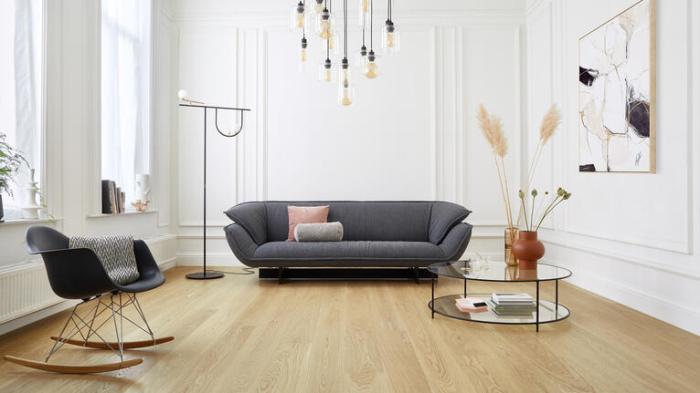
Source: tarkett-image.com
Scandinavian design, with its emphasis on functionality, minimalism, and natural light, translates beautifully into various rooms of the home. The following examples illustrate how these principles are applied to create inviting and aesthetically pleasing spaces.
Scandinavian Living Room
Imagine a living room bathed in the soft, diffused light of a Nordic winter. Large windows, perhaps reaching from floor to ceiling, allow ample natural light to flood the space. The walls are painted a soft, warm white, creating a neutral backdrop that enhances the natural light. The floor is covered in light oak planks, adding warmth and texture.
A plush, light grey wool rug anchors the seating area, providing a cozy contrast to the lighter flooring. The furniture is simple and functional: a comfortable, low-slung sofa in a light grey fabric, two armchairs upholstered in a natural linen, and a coffee table made from light oak. Textiles play a crucial role, adding warmth and personality.
Woven throws in muted shades of grey, beige, and cream are draped over the sofa and armchairs. A few carefully chosen accessories complete the look: a simple ceramic vase filled with dried flowers, a few well-worn books stacked on the coffee table, and a hand-knitted blanket casually tossed over the arm of a chair. The overall effect is one of understated elegance and calm serenity.
Scandinavian Kitchen
A Scandinavian kitchen prioritizes functionality and natural materials. The cabinetry is typically made from light-colored wood, such as birch or pine, with clean lines and simple hardware. The countertops are often made from a durable, natural material like light-colored stone or butcher block, adding a touch of rustic charm. Open shelving displays carefully chosen crockery and glassware, adding a touch of personality.
A minimalist approach is taken to appliances, which are integrated seamlessly into the cabinetry. The backsplash might be a simple white subway tile or even just painted in a light, neutral shade. Natural light is maximized through the use of large windows and strategically placed lighting. The overall feel is clean, bright, and inviting, emphasizing the natural beauty of the materials used.
A single, statement pendant light hangs above the kitchen island, adding a touch of modern sophistication.
Scandinavian Bedroom
The Scandinavian bedroom is designed to promote relaxation and rest. The color palette is typically muted and calming, featuring shades of white, grey, beige, and soft pastels. Natural materials are emphasized, such as linen bedding, a wool rug, and a wooden bed frame. The bed is typically the focal point of the room, dressed with high-quality linens in natural tones.
A simple, yet elegant, headboard made of wood or upholstered in a neutral fabric provides a touch of sophistication. Lighting is crucial in creating a restful atmosphere. A soft, ambient light is provided by a bedside lamp with a fabric shade, perhaps paired with a dimmer switch for adjustable brightness. A simple window treatment, such as sheer curtains, allows natural light to filter in during the day while maintaining privacy.
Minimalist décor is employed, with only a few carefully chosen accessories, such as a small plant, a framed print, or a few carefully selected books. The overall atmosphere is serene, calming, and conducive to restful sleep.
Final Thoughts
From its minimalist aesthetic and emphasis on natural light to its use of sustainable materials and carefully curated accessories, Scandinavian interior design offers a refreshing approach to creating a comfortable and stylish home. By embracing simplicity, functionality, and a connection with nature, this design philosophy provides a timeless and adaptable style that transcends fleeting trends, offering a calming and inviting atmosphere for years to come.
The careful consideration of light, color, and texture ultimately results in spaces that are both beautiful and functional, reflecting a deep respect for both craftsmanship and the environment.
Clarifying Questions
What is the difference between Scandinavian and minimalist design?
While both prioritize simplicity, Scandinavian design incorporates warmth through textures and natural elements, whereas minimalist design often focuses on stark functionality and a limited color palette.
How can I incorporate Scandinavian design into a small space?
Utilize light colors, maximize natural light, and choose multifunctional furniture to create the illusion of spaciousness. Mirrors can also help to reflect light and expand the perceived size of the room.
Are there any specific plants that work well in a Scandinavian interior?
Plants like fiddle leaf figs, snake plants, and succulents thrive in bright, indirect light, complementing the Scandinavian aesthetic and adding a touch of life to the space.
How expensive is it to achieve a Scandinavian look?
The cost can vary greatly. While some iconic Scandinavian furniture pieces can be pricey, the style’s emphasis on natural materials and simple designs allows for budget-friendly options through repurposing and careful sourcing.
Where can I find inspiration for Scandinavian interior design?
Numerous online resources, design blogs, magazines, and social media platforms showcase stunning examples of Scandinavian interiors, offering a wealth of inspiration for your own projects.


